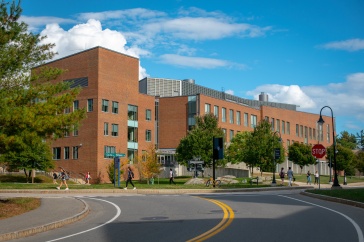
New UNH research has uncovered a novel way of studying protein interactions which may improve the efficacy of a class of drugs — called allosteric drugs — that treat diabetes, cancer, cardiovascular disease, and neurological disorders. The research also has the potential to significantly cut time and cost of preliminary allosteric drug design by incorporating a new form of computer simulation analysis.
The research, which was published in the Biophysical Journal, has laid a foundation for future analyses of allosteric drugs. Allosteric drugs are used for a wide array of therapeutics ranging from general pain relief to inhibiting cell-to-cell communication in tumors. The drugs target proteins that carry messages, called signals, that drive cellular activity, and they disrupt those messages, which is important if that message is what’s causing the disease. Allosteric drugs also increase a protein’s drug affinity, which allows other drugs to be effective at lower dosages.
Despite the widespread use of allosteric drugs as therapeutics, they are often difficult to develop because of researchers’ limited ability to predict how proteins will change when the drugs bind to them.
“Our study found that different proteins that look alike in terms of their static structures can vary in how they react when bound to an allosteric drug,” says Harish Vashisth, associate professor of chemical engineering at UNH. This contrasts with the long-held notion that protein sequence structure rigidly defines this aspect of their behavior.
Vashisth and doctoral student Yong Liu got around the limits of conventional protein analysis by using bioinformatics computer programs to simulate allosteric binding interactions on a protein and display all the potential changes that could occur. They started with five structurally similar proteins that are involved in regulating G-protein signaling. G-proteins act as an intermediary in the delivery of a signal between the exterior and interior of a cell. They’re like a switch that’s connected through a wall: push a button on one side and a light comes on the other.
The researchers then introduced an inhibitory molecule to stop the G-protein signaling and analyzed the results. Each of the five G-proteins reacted differently, despite their structural similarities.
“This simulation of changes brought on by drug binding is broadly applicable to any protein family, any inhibitory compound, and any pair of sites on protein structures in general,” says Vashisth. “Our analyses convincingly demonstrates that pathways for propagation of signals are indeed distinct among structurally similar proteins.”
Conducting these simulations prior to running experimental drug trials can reduce the time and resource cost of research by narrowing down early candidates, and, says Vashisth, lead to improved design of allosteric drugs.
The study was supported by a recent National Institutes of Health Maximizing Investigators’ Research Award (MIRA), the National Science Foundation and by the UNH Center for Integrated Biomedical and Bioengineering Research (CIBBR). The research had computing and instrumentation support from UNH’s Research Computing Center and NH EPSCoR’s NH BioMade.
CIBBR is committed to supporting paradigm-shifting research that is often conducted in the space between research disciplines, as well as enhancing biomedical research infrastructure at UNH. The Center, which is funded by a $10M Center of Biomedical Research Excellence (COBRE) grant from the NIH, aims to accelerate the translation of basic biomedical and bioengineering research into innovative tools and treatments to improve human health and well-being.
-
Written By:
Ryan Wilmot | UNH College of Life Sciences and Agriculture
















































